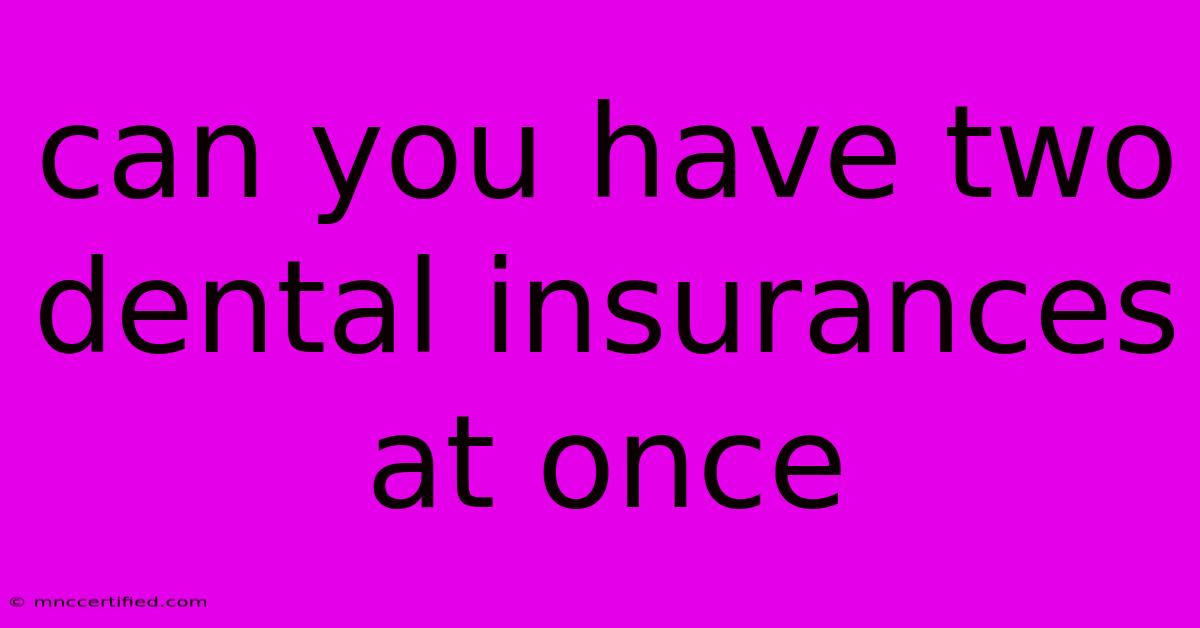Can You Have Two Dental Insurances At Once

Table of Contents
Can You Have Two Dental Insurances at Once?
Having dental insurance can save you a lot of money on essential dental care. But what if you have access to two different dental insurance plans? Can you use both to maximize your coverage and minimize your out-of-pocket costs?
The answer is a bit more complex than a simple yes or no. While it's possible to have two dental insurance policies simultaneously, whether you can actually use both depends on several factors. Let's dive into the details.
Understanding How Dental Insurance Works
Before we explore the specifics of dual coverage, let's understand how dental insurance generally operates.
- Premiums: You pay a monthly fee to your insurance provider.
- Benefits: Your insurance plan covers a certain percentage of your dental expenses, typically capped at a maximum annual benefit.
- Deductible: Before your insurance kicks in, you usually have to pay a certain amount out of pocket, known as the deductible.
- Co-insurance: Once the deductible is met, you usually share the remaining cost with your insurance company, paying a percentage of the bill.
- Waiting Periods: Some procedures may require you to wait a certain period after enrolling before they're covered.
The Rules of Dual Coverage
Now, let's address the main question: Can you use two dental insurance policies at once?
The short answer is: it depends.
- Coordination of Benefits (COB): Most dental insurance plans have a COB provision that determines how benefits are paid when you have multiple insurance policies. This provision usually dictates that one plan is the primary and the other is the secondary. The primary insurer pays first, and the secondary insurer covers the remaining costs up to their policy limits.
- Plan Restrictions: Some plans explicitly state that they don't allow double coverage or have specific restrictions on using two plans simultaneously.
- State Regulations: Some states have specific laws regarding dual insurance coverage.
What You Need to Know
- Check Your Policy Documents: Carefully review the terms and conditions of both your policies to understand their COB provisions and any restrictions on dual coverage.
- Contact Your Insurance Providers: Reach out to both insurers to clarify their specific rules and procedures regarding dual coverage.
- Be Prepared to Explain Your Situation: When you visit your dentist, be prepared to inform them about both insurance plans and provide all necessary information for billing purposes.
Potential Benefits of Dual Coverage
Here's how you might benefit from having two dental insurance plans:
- Increased Coverage: By combining the benefits of two plans, you may have a higher overall coverage limit and access to a wider range of services.
- Lower Out-of-Pocket Costs: With dual coverage, you might have to pay a smaller deductible and co-insurance for your dental care.
Potential Drawbacks of Dual Coverage
Be aware of these potential drawbacks:
- Administrative Complexity: Managing two insurance plans can be more complex than managing one. You need to keep track of coverage details, deductibles, and payment schedules for both policies.
- Potential for Conflicting Benefits: The COB provisions of your plans may not align perfectly, leading to disagreements or delays in payment.
- Higher Premiums: While you may save on out-of-pocket costs, having two insurance plans also means paying two premiums, which can increase your overall expenses.
Alternatives to Dual Coverage
If you find that dual coverage isn't a suitable option for you, consider these alternatives:
- Family Plan: If you're part of a family, check if your plan offers a family plan that covers multiple individuals.
- Upgrade Your Existing Plan: Explore whether you can upgrade your current plan to a more comprehensive one with higher coverage limits.
Conclusion
While it's possible to have two dental insurance policies, whether you can actually use both depends on the specific provisions of your policies, state regulations, and your individual circumstances. It's crucial to carefully review your policy documents, contact your insurance providers, and understand the potential benefits and drawbacks before making a decision.
Ultimately, the best approach is to weigh your individual needs and financial situation to determine if dual coverage is the right choice for you.

Thank you for visiting our website wich cover about Can You Have Two Dental Insurances At Once. We hope the information provided has been useful to you. Feel free to contact us if you have any questions or need further assistance. See you next time and dont miss to bookmark.
Featured Posts
-
West Indies Bowling Attack Leads Decider Changes
Nov 07, 2024
-
Wisconsin Constitution Now Bars Affirmative Action
Nov 07, 2024
-
Election Map Trump Wins 2020
Nov 07, 2024
-
Does Insurance Cover Lactation Consultants
Nov 07, 2024
-
Rigetti Back In Compliance With Nasdaq
Nov 07, 2024